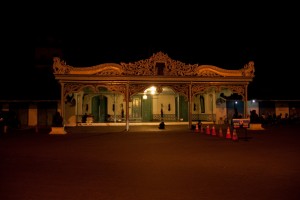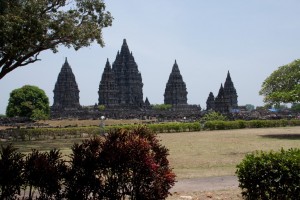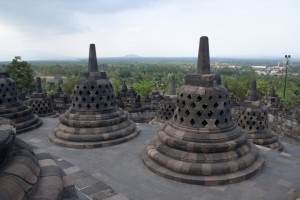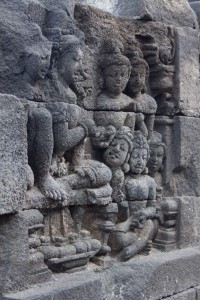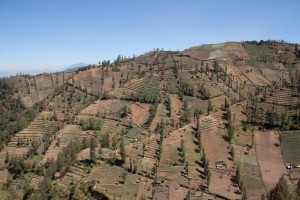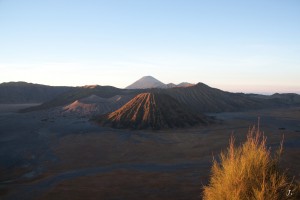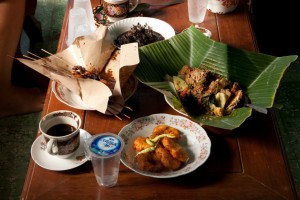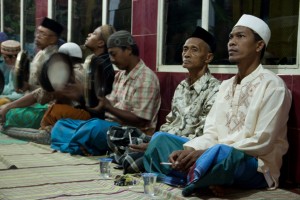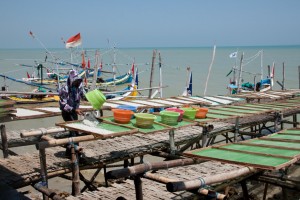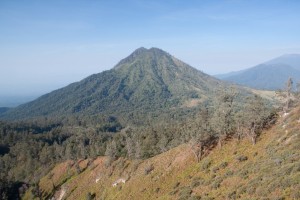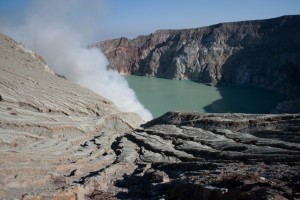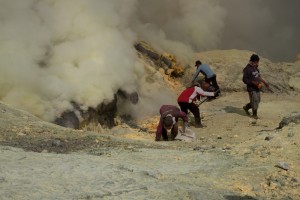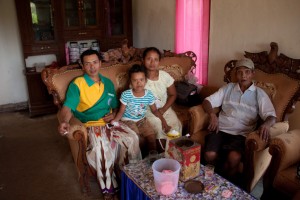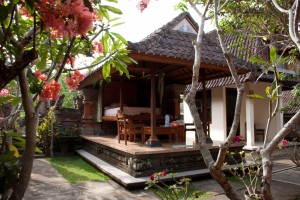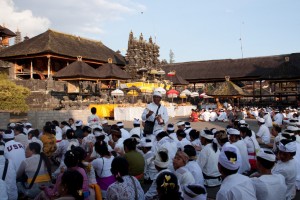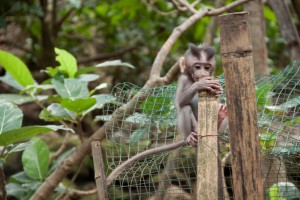Getting to Solo and first impressions
My trip to Indonesia happened rather by chance. There were two things making this a great travel opportunity you simply have to go for. The first was that my friend Tea was doing her exchange semester there, so this would allow me to get to know the local life easier. The second thing was a very cheap flight ticket from Stockholm to Jakarta. Even with the detour over Sweden it was still a great deal (370 EUR).
After being 4 days on the way and absolving all my stop-overs I was on the plane to Jakarta. Although it was an overnight flight I couldn’t sleep much. The plane was shaking all the time because of the turbulences above the Indian Ocean and the crew was checking the plane. It didn’t matter that I was sleeping in the horizontal position as long as my seat and table was in the vertical position and they could see seat belts fastened around me they were not trying to wake me up. After a small breakfast the plane was about land in Jakarta at 5 am local time.
It was my first time in the Far East. I didn’t have any expectations, even if I would hear like hundred stories about Indonesia it probably wouldn’t be enough. You simply have to experience this part of the world on your own.
When I went through the door of the aircraft, it felt like entering a sauna. The air was very warm and humid. The airport was built in some local architecture style and looked really exotic ..at least the international terminal. Now I had to move to the domestic terminal for my connecting flight to Jogja (Yogyakarta). The domestic terminal was really crowded which was indeed pointing out the fact that Indonesia is the 5th country in the world with the most population. To enter the terminal you had to show the flight ticket to the security control and go through a security check. I was tired so I went to the gate to sit there and rest. The information system on which flight is to board was not working, but there where announcements in Indonesian and usually in English (not always easy to understand) as well. So I had to pay attention and as a tourist I was an attraction (yes, even at the airport) for the locals, who were smiling at me and taking pictures with me. I immediately felt welcome in this country.
It was time to board Air Asia Indonesia to Jogja. We walked to the plane; let the people get off the plane and the got on the plane. Obviously the plane was commuting the whole day on that route. Air Asia Indonesia is referenced on the Internet as one of the better airline maybe because of the fact that its competitor Lion Air has already ‘experience’ with landing on water. I was looking forward to see Indonesia from the window, but I was just too tired and felt asleep soon after taking off. When I woke up the plane was already descending to Jogja and you could see the hilly land north from Jogja. I was looking for the city of Jogja, but couldn’t see it. After landing, I was happy to change for a train to Solo (Surakarta) as this was my fourth flight in a row already. Equipped with an Indonesian dictionary I walked towards the train station, just for the case the warnings from my friend Tea like “nobody speaks English here, so good luck” turn out to be true. But I was rather lucky. A guy started to talk to me in English when I left the airport. First he wanted to arrange a taxi for me, but when he realized I am not interested, he showed me the train station and helped me to buy a ticket.
From the train you could see already typical Indonesian countryside with rice fields, banana trees and coconut palms. Villages with small houses and dozens of motorbikes at every railway crossing. A guy came to me on the train and started to talk with me. He was a student at one of the universities in Solo. He was very friendly, but we didn’t get much over the small talk like ‘what’s your name, where are you from and what are you doing’. When we got off the train in Solo he offered to give me a lift to the university. I couldn’t figure out if he’s talking about his university or university I was heading to. So I decided to walk. I had a plenty of time, because I arrived quite early and Tea still had classes.
With some 600 000 inhabitants is Solo rather a small city, in culture and arts in has a lot to offer though. Unfortunately, I didn’t have enough time to experience it. Soon I realized it’s not a good idea to walk, because there were no sidewalks and it was really warm. People actually don’t walk much in the cities. They either go on a motorbike or by bus or simply take a riksha or other kind of taxi. I caught a bus as walking to a bus stop is not really common here. The bus was rather small, full of people, and you could tell that it lived a lot already. There was a driver and a manager. The manager was collecting money from the passengers and when someone wanted to get off he knocked with his ring on a metal bar. Sometimes he was even trying to persuade some people on the street to take the bus. The bus took me close to the university, where I was supposed to meet Tea. Even I had a modern navigation with updated maps, I had to ask for directions. Information from the Internet or touristic guides is usually just approximate. Depending on how lucky you are is the deviation from the real location. Also when you ask you always get an answer, but this is not always necessary a correct one. So one should at least double check.
I was sitting at the campus of ISI University in Solo. The university buildings were in a local architecture style and between the buildings was a park. It was a really nice place, calm and peaceful. I was happy I reached my destination after long time of travelling. I thought in that moment this is like the end of the world. It was nice to meet my good friend again. From the campus we walked together to Wisma. Wisma is a kind of student’s house with canteen and stage for performances. We stayed just for a small snack there and went on to Tea’s house or house share to be more precise. The city of Solo is quite large in the mean of urbane area. However most of the houses have one store maximum.
Tea lived in a common Indonesian house. It had a wide corridor leading to five rooms, a kitchen, balcony and a bathroom. There were no windows, just window shutters. Water supply was from a tank on the roof, where it was being warmed up by the sun and the water itself was delivered by the local authorities almost every second or third day. You could find just few ‘western’ elements in the house, the guys living there adapted mostly the Indonesian style of living. The house was shared by 5 exchange students from different countries.
In the evening, we went for a dinner and walk to the city center. It is not common to cook at home in Indonesia. You get a meal in any of the Warungs (local name for a restaurant) for approx. 1 US dollar. As I became an IDR (Indonesian Rupiah) millionaire on that day just by exchange couple of US hundred banknotes I thought I have to enjoy that. The exchange rate in Indonesia is crazy as well as the purchasing power of the western people there. We went to a street that is known in Solo for eating local specialties. Unfortunately, on that day, most of the warungs there were closed already. We had a soup with a lot of vegetables and pieces of meat and talked about our impressions.
After the dinner we walked to the former royal palace Kraton and on the way I tried local specialty, which was actually a pancake made of coconut milk, rice flour with toppings. If you ever get to Solo ask for “Srabi”. And that was the end of my first day in Indonesia. I skipped the movie screening at Wisma and went to sleep, because I was really tired. Tea is an experienced CouchSurfer so I had a perfect couch ready to sleep on.
Candi Prambanan and Candi Borobudur
On my second day I wanted to visit Prambanan and Borobudur. Tea had classes the whole day so I was on my own. First I was a bit worried how I will get around as I didn’t know Indonesian and was not so familiar with the local transportation system. Googling stuff does not always work here. Actually, Tea asked for me how to get to Prambanan: Just go to the main street, catch a fancy bus and say that you want to get off in Prambanan. Very simple indeed. I went to the main street to catch a bus. In the beginning there was no bus going. Then I caught a bus, which was apparently not fancy enough and although the “bus manager” told me it’s the right bus to Prambanan it turned out that it’s just some city bus going around Solo. So I got off the bus and caught another bus. It was not much fancier, but it was going to Prambanan.
Travelling on the bus I was relaxing. The distance from Solo to Prambanan is 50 km and the bus needed some two hours for that. Roads in Central Java are really busy with all possible means of transport from horses to big trucks, but especially many many motorbikes. The average moving speed is maybe 30 km/h. You have enough time to observe what’s happening around. When traveling by bus, there is usually some local music playing either from the radio or performed by local artists with homemade instruments. Sometimes there are people selling foods or snacks.
When I got off the bus in Prambanan I couldn’t see any temple or any signs pointing to the temple, so I tried to ask people around. This day I was not so lucky with meeting English speaking people. I looked up what I wanted to say in a dictionary and this way I slowly started to learn Indonesian (Bahasa Indonesia). The temple was not far. I was walking towards the ticket office (for international visitors). There were some folks selling some fruits and shouting, offering me their fruits. Even when I didn’t buy anything they were happy to exchange few words and smiles. I got a ticket and a sarung (typical for Hindu temples) and went inside. I passed by another ticket office with labels only in Indonesian and prices ten times lower. Anyway, just from my appearance they would realize immediately I’m not local so it was not even worth trying.
The temple area is huge. The temple itself consists of 4 shrines built up from a lava stone and dedicated to the main gods. The workmanship is amazing. It’s definitely a must see.
To go to Borobudur (the Buddhist temple) I had to go over Jogja. Borobudur is some 50 km northwest from Jogja. I was hoping that there might be some direct touristic bus from Prambanan, but no. So I caught a bus to Jogja. It was already 2 pm and I realized by the current speed of the current mean of transportation it would be difficult to get back to Solo in a reasonable time. I should mention that Tea and I wanted to leave for Bromo by a night train from Solo that evening. The bus went to Jogja bus terminal. It passed by the city center so at one point I thought already I missed the stop in Jogja. At the bus terminal some guys immediately started to talk to me asking me where I need to go and offered me a taxi. A taxi is relatively expensive and slow, because of the traffic. The best way is to go on a motorbike. I asked the guy if he can take me to Borobudur on a motorbike and started bargaining. I was in a complicated situation for bargaining, because was not familiar with the local prices yet and didn’t how is the road. First he said 200 000, so I said 150 000 and we agreed on 170 000 (cca 17 USD). Later on my trip I mastered the bargaining techniques and was able to get quite good prices.
We got on his motorbike and drove through the streets of Jogja. It was now a new perspective of seeing the traffic and feeling the traffic. Traffic rules are not being really followed. People go by common sense and respect and it’s working somehow and they get where they need to. My driver was driving fast but safely. Still it took us hour and a half to get there.
Borobudur – one of the largest Buddhist objects. It consists of six square platforms having nearly hundred statues of Buddha on each. On the walls there were reliefs from daily life of ancient Javanese or stories from the history. The place is set to beautiful scenery of Central Java between volcanoes. Another must see.
There were not many ‘white’ tourists and the Asian visitors were asking me all the time if they can have a picture with me. The more religious ones (Islamic girls), asked for an autograph. And they were all happy about it.
My driver was waiting for me and we went back to Jogja. Back in Europe I don’t drive motorbike so I could really feel my butt after the long ride. But that was just the beginning. I paid my driver and got on a bus back to Solo. I arrived at 7 pm in Solo and it was already dark. In Indonesia it gets dark very quickly after the sunset and daylight is from 6 am to 6 pm.
Our train was departing just before midnight and should reach Malang, our destination, at 5 am. It was almost empty. We could stretch over the double seat to sleep more comfortably. It was almost perfect but the air condition. It was set probably to 16 degrees Celsius and even though we had sweatshirts and a sleeping bag, we woke up because of the cold couple of times. The locals were travelling on the train in jackets and hats …probably in the warmest things they have at home.
Bromo
We set up an alarm clock, but I woke up a bit earlier. The train was almost empty and from the window you could see sun rising above the rice field with shapes of mountains and a volcano in the back. According to GPS we were approaching Malang already so I decided to wake up Tea who was ignoring the alarm clock and still enjoying her sleep completely covered with a scarf and sleeping bag – absolutely according to the Islamic dress code.
Outside it was nicely warm already and as the sun was rising the temperature was rising quickly to the common 32 degrees Celsius. We had some information printed from the internet and knew more or less how to get to Bromo. Immediately after getting off the railway stations there were guys offering us a ride a talking to us. Tea knew Indonesian pretty well already. Actually, I was really impressed how quickly she learned the language and she was able to manage basically everything during our trip. We took a mini bus to the bus terminal, where we changed for another mini bus to Toempang. As tourists they were trying to cheat us on price. We usually found out by asking or it was even written in the bus what the price is – so we got the difference back, but still it was quite embarrassing.
Toempang was just a bigger village. There we realized that there is no kind of public transportation to Bromo. We could either rent a jeep, which was expensive, or go with a motor biker or simply go by foot, which was a bit far. But first we went for a breakfast. In Indonesia there is not a big difference between the meals so even for breakfast you get rice with vegetables or some meat. Getting up early and the tropical climate (it was my 2ndday) was not a good combination for me and even though I wanted to try as many things as possible I simply didn’t feel like eating much. After finishing our breakfast, visiting a local tourist office (only Indonesian speaking), we ended up bargaining with guys with motorbikes.
We were on our way with two guys on two motorbikes to Ngadas – a mountain village at the edge of the Bromo caldera. The wind on the motorbike was refreshing and it was nice to sit in this open space and look around. The road was getting steeper and steeper and you could feel the backpack on the back a bit. When we started to climb up the mountain on the motorbike it looked like we are entering a kind of rain forest. The road was narrow and bumpy. Especially when a jeep was passing by we had to be careful. When we were approaching Ngadas, the forest disappeared. Instead, there were fields with vegetables on the steep mountain sides reaching up to the top. With the small paths for the farmers, it looked really impressive. Our ride ended exactly at the gate to the national park, where you had to pay a fee for all those beautiful views.
Now the hiking part started. From Ngadas it was 12 kilometers to Bromo. It was noon and it was quite warm for hiking up a mountain in the sun. Well, the Czechs are used to hike in the sun, because they do that on their holidays in Croatia, but not the Croatians. Slow but steady we reached the top of the mountain chain. A great view on a part of the caldera with volcanoes in the inner side opened in front of us. The whole scenery was very colorful and the colors were very intensive. The path started to be very sandy and there was more and more sand when we were descending to the bottom of caldera. Later it was only dark sand, which was really warm in the sun, and in which we were sinking with every step. Despite this fact there were guys on motorbikes going around either for fun or trying to catch some tourists and give them a ride (for money). Of course they got stuck in the sand from time to time and there was always huge cloud of dust and sand behind these desert riders. Yes, the landscape basically turned into a desert after some time. Actually it was called the sandy ocean. The wind got stronger and we couldn’t escape the sand, it got everywhere. When we reached the village of Bromo we looked like two chimney sweepers.
At the beginning of the village there were some guys that started to talk to us immediately and Tea asked about accommodation. They offered us to have a look at a homestay. We agreed. Homestay is basically a room in a house of a local family. In this case there was a small room where the landlord lived and two rooms in the ground floor and some more rooms in the basement. The toilette (Turkish) was ensuite, but bathrooms were located in the basement. They were typical Indonesian mandi (Indonesian word for bathroom) with bathtub partly filled with water and a bucket for pouring water on yourself. Water should be coming out of a tap. This was not the case here; nevertheless the landlord said it will work later in the evening, same as the electricity. Well the bathroom didn’t look like a place where you would love to have a relaxing shower after a long day, but it would do the job of getting rid of the sand.
After our short walk in the late afternoon we realized at our homestay that the electricity was already working, but still no water. We didn’t think nice of our landlord. I wouldn’t mind it was cold outside to take a shower, but I didn’t want to go sleep and not having a shower for two days. Anyway, there was no other choice.
We woke up at 2 a.m. to hike up to a view point located above the village to see the sunrise over the caldera. We didn’t have any torches with us so we used a mobile phone to see where the path is leading. It was a wide hiking path. On the mountain you could see fires made by locals to warm them up while waiting for tourists to sell them some refreshments. Above our heads there was clear dark sky with millions of stars. Not many places in Europe have a sky like this. We climbed up to a view point that was a bit below the top of the mountain. The path leading to the top was very narrow and we didn’t have any good equipment so we decided to stay there. And it was dawning as well. You could see lights of jeeps going up to the top of the mountain with tourists. Obviously the top of the mountain can get very crowded. At our view point there some 20 people in the end. As the sun was slowly rising the clouds were nicely illuminated. The sun rays were opening the view on amazing caldera.
When the show was over we walked back down. On the way we met some Asian tourists that wanted to take a picture with us (nothing uncommon there as you may have noticed already). We walked through the village and met farmers on their way to the fields. One of them was offering us his vegetables. Our next stop was the Hindu temple. Again we were crossing the desert. It was like a huge sand box and we were considering building a sand castle. The temple looked really interesting from outside, but, unfortunately, it was closed so we didn’t see much. Passing by some improvised stands with refreshments and group of men with horses offering a ride we reached a path that later changed into stairs leading to the top of the crater Bromo.
The closer to the top we were the more intensive the smell of sulphur was. Seeing the crater was very impressive and barely describable with words.
On the way back Tea was bargaining with the men with horses for a ride back to the village. It was not easy, but in the end they agreed. It’s still better for them to get some money than no money. It was nice to sit for a while. From time to time the horse wanted to go his own way so the guy had to pull him a bit. And be aware of the horse spits. I don’t have any experience with that, but I heard they are really hard to get rid of.
So that was Bromo. We caught a mini bus that was going to Probolinggo. First, he went the other direction. We thought already the driver got lost, but he just picked up two more people. There people usually don’t go to the bus, the bus goes to them. Even if it’s just a distance of 100m. Going downhill by the minibus felt like being on a roller coaster. The mountain was quite steep and the bus was not really robust, so you could fully feel the ride. In Probolinggo we changed for a bus to Surabaya. All together it took us couple of hours to reach Surabaya.
When we reached Surabaya it was late afternoon and it was getting dark soon. The Surabaya bus terminal we arrived at was located a bit outside of the city so we took a local bus to get closer to the city center. Surabaya look much more civilized and western like than any other city in Indonesia I’ve been so far. We walked through the city, trying to find some accommodation. Obviously Surabaya as the second largest city in Indonesia with 3 mio inhabitants was too big to find a cheap accommodation just by walking through the city. Not to mention that we got up at 2 am and were tired already. So in the end we walked into a Starbucks, got a coffee which price was equivalent to 3 meals in Solo, connected to a free Wi-Fi with an iPhone, started an app and based on our GPS location we got list of available accommodation sorted by price. So hi-tech:) We picked a homestay just 1,5 kilometers away. I was just a bit skeptical about the accuracy of the information. Especially the location information can be tricky, because the addresses are not as exact as in Europe (not one street – one name but one name – many streets). We were following google maps and ended up in a district that looked like some poor district. Tea asked some locals about the homestay. Nobody knew. We went back, because we saw a hotel with a reasonable offer on the way. But then a guy on a motorbike came saying that he knows where the homestay is. Google was almost right, just two parallel streets away.
The homestay was really nice, comfortable and well equipped. We had a shower, arranged a motorbike rental for the next two days to go to Madura and went to sleep. Happy end of a long day.
Madura
For the next two days we decided to visit the island of Madura. Madura is a neighboring island to Java. It is located in the northeast, much smaller and connected to Java by the longest bridge in Indonesia.
We rented a motorbike which is almost the fastest mean of transport there and gives you the flexibility to go wherever you want. I don’t drive motorbike back in Europe. Tea drove a motor bike already several times and two days she proudly told me that she drove a motorbike to the city center of Solo for the first time! So she was an experienced driver and we decided that she’ll drive.
We woke up early so we went to have some breakfast on the street and told the guy at the reception if we can have the motorbike delivered as early as possible. In the end it was delivered only one hour later than the time we agreed the day before.
The road trip started. Tea was driving and I was carrying the backpack on my back and navigating her with my phone in my right hand. She was doing great with driving and we managed to get on the bridge connecting Surabaya with Madura (simply called the Suramadu bridge). The bridge is 5 kilometers long. People on Madura have their own language (Bahasa Madura) and their own culture and customs, which are slightly different to the Javanese.
We took the road along the northern cost of Madura. According to the travel guide we should see dry Mediterranean style landscapes, however neither me nor my Croatian friend could really recognize them. There were other beautiful and interesting things, though.
On Madura the prevailing religion is Islam. Almost every village has its mosque, which has a unique design, and likely in Europe they build it as the most beautiful building in the town. We stopped at one of these mosques and went inside to have a look. Immediately, all the people at the mosques were greeting us and welcoming us. It was a boy school in deed and some of the guys knew a bit English. They told us about their school and classes. Of course we couldn’t skip taking a group picture of all of us together. When we were leaving, the priest gave me a prayer’s scarf as a present.
The road was still quite far from the sea so we decided to check out the sea and turned to a side road leading to a coast village. In the village there was a big bay with a dock for ships. The coast was rather messy. Tea got into a talk with a local guy, which invited us later to his house for a lunch. His wife has been working in the US and she knew English pretty well. On their ground there were two houses and let’s call it animal corner. The guy was keen on farming. In their house their little son was playing on the ground. First they served us coffee. It was a Turkish like coffee with cinnamon sticks inside. Then they brought probably everything they had. It was amazing. We could try squids, the local specialty – sate Madura and nasi according to a local recipe. Everything was delicious and we were quickly full just by trying a bit of each meal. The desserts were excellent finishers. They had shiny colors and most them were fully natural.
When we were leaving the village we stopped at a huge arena, which was intended for bull races. These are typical for Madura. Although there were quite many people around the place, there were no bull races on that day.
It was quite late already and we knew we won’t make it to Sumenep before it gets dark. In the end we decided to drive even when it gets dark, because according to the guide on the Internet there were the most interesting places on Madura. My driver had to drive more carefully and I could hardly sit on the motor bike with the backpack. The road was mostly all right and there was not much of traffic.
Few kilometers before reaching Sumenep we passed along a house with some music playing. It seemed to be a kind of celebration or ceremony. We stopped and went to check it out. There were men sitting on the ground, playing musical instruments, singing and dancing. It was celebrating an Islamic holiday on that day. The younger guys were rather playing something on their mobile phones while their elder peers were dancing with passion on Arabic melodies. Very nice experience. We didn’t stay long, because we needed to find an accommodation for us.
Sumenep seemed to be rather a small town. When we were driving through the city center we saw a lot of people celebrating. Most probably because of the holiday. We had some on accommodation noted so we just asked how to find it.
We picked a hotel that was mentioned on the Internet as a businessman’s choice. They had only the cheapest (for 5 USD/night) available. The room had two beds a table and a ventilator. The equipment was rather historical and the cleaning lady was probably on holidays for a long time already. Bathroom was typical Indonesian mandi. This time I went for the mandi experience. I’m used to take this kind of bath when I do camping, but in a hotel it was a completely new experience to me.
The next day we drove few kilometers north to the Madura’s most famous beach. The Lombang beach is a sandy beach with soft sand. When we reached the beach there was nobody lying on the beach or swimming in the sea. Some kids were taking a lesson in a gazebo. We tried to put on as much covering swimming suites as possible and went to swim in the sea. The water was very warm, but still refreshing. Meanwhile more people arrived at the beach and when we came out off the water they immediately walked to us and talked to us. After having a typical small talk they took pictures with us.
On the way back I tried driving, because I wanted to rent a motorbike in Bali. The motorbike had an automatic transmission so it was really easy to drive. One only had to be careful at crossroads to pick the right lane, because in Indonesia people drive on the left side.
Back in Sumenep we didn’t do any sightseeing. We walked around the city center the previous day in the evening and apart from the mosque and the royal palace next to it, we didn’t find anything else worth seeing. South to Sumenep we passed by a desalination plant. This is according to the Internet guide the oldest industry (and probably the biggest as well) on Madura.
We were heading direction Surabaya. On the way we stopped at couple of places that caught our attention. When we wanted to get closer to the sea, we found a fish factory. We went in and the people showed us kindly how they prepare the fish for drying. Then they dry the fish outside in the sun. On the sea in front of the factory we saw their colorful fishing boats.
We made one more stop for our favorite young coconut. It was always refreshing in the heat. We have reached Surabaya quite early. After handing back the motorbike we went for a good-bye dinner to one of the warungs close to the center.
My guided tour in Indonesia came to the end. The following days were a practical test of my Indonesian.
Kawah Ijen
At the Purabaya Bus Terminal our ways split and I said good bye to Tea. I was on the bus to Probolinggo. There was some Asian music playing (as always) and as it was a fancy bus there were video clips with karaoke. I used the time to learn Indonesian. The motivation was strong, not to be lost in some situations. And you learn quickly when there is no other option.
In Probolinggo I changed for a bus to Bondowoso. It was a kind of direct line to Bondowoso which should be faster than going via Situbondo. The bus was definitely not the youngest in the fleet and when we were climbing up to the Bondowoso highland it made noises like it should brake in pieces. But there were plenty of trees around to catch us in such case:) ..and the amazing view from the serpentines was enough of compensation.
In Bondowoso you could feel the breath of the mountains already. The air was colder and fresh and it seemed that there is rain coming. After getting off the bus there was a guy that immediately started to talk to me in English asking me where I am going. When I said that I want to take a bus to Kawah Ijen he said that there is no bus on that day but he can take me there for 150 000 IDR on motorbike. I didn’t trust him at first because I had this information that there should be a bus going. I looked around the bus terminal but I didn’t really see any bus to Kawah Ijen. At the information office they confirmed that there is no bus on that day, only on the next day. I didn’t want to lose time in Bondowoso and started bargaining with the motor biker. When he said it’s some 40km I offered him 100 000 IDR. He was trying to convince me for a higher price but then he has accepted my offer.
He brought his motorbike, smoked a cigarette, and we were ready to set off. We left Bondowoso through an old railway bridge transformed to a one lane bridge for motorbikes with couple of guys organizing the traffic there so it could be used for both directions. All kinds of settlement quickly disappeared and we were driving in a jungle. The road was very narrow and quite bad at some points and I was wondering if it was suitable even for a microbus. When we reached the top of the mountain chain the vegetation changed and a marvelous view over the Ijen Plateau opened in front of us. We drove on through several security check points. Some of them let us drive thru; at some we had to register in a kind of guest book. We passed the village of Sompol and at the end of the Ijen plateau, after driving for more than 2 hours, we have reached Kawah Ijen. It was a long drive and the guy was complaining all the way that it is impossible for him to drive this just for 100 000 IDR. Well, I admit it was a long drive and he has to drive back to Bondowoso now and I would give him a bit more money but I was running out of cash and did not know exactly how much money will I need till I get down to an atm. In the end he was happy with the 100 000 IDR anyway.
At my destination there was a group of houses, of which part was for the tourists and part was for the mine workers, a sign pointing to a path and telling you that you can reach the crater Ijen by walking 3 km by foot and one arrogant guy, who I hated from the very first moment. As there were just few accommodation possibilities I had to accept his offer of an overpriced, dirty and noisy room without water to take shower.
It was already late so I went just for a walk. I met last sulphur miners carrying the sulphur from crater Ijen and few tourists. From the hiking path there was a nice view over the Ijen plateau and the neighboring mountains which were volcanoes once.
When I came back from my walk I saw a long fire stripe spreading over crater Ijen. I got in talk with a guy that was taking pictures of the fire as well. He said that he is visiting that place quite often as he is working on a project that would bring water from the neighboring mountain to the settlement. It was the first time he has seen such a fire there. Well, lucky me I though. Still I was a bit worried if I will be able to reach the crater and the sulphur lake the next day.
For early birds there is a phenomenon at crater called the blue fire. At 2 am a special kind of gas comes out of the crater and it burns with a blue flame. Because of the fire on the crater I rather skipped this attraction and went to sleep.
The morning invasion of French tourists in jeeps did not let me sleep long. I got up early to hike to the crater Ijen. The fire was gone, there was not even smoke left. The only thing what was left were burned bushes along the path. Right at the beginning of the path I got in talk with one of the miners. Well, let’s call it rather a small talk. In combination with his English and my Indonesian we could exchange just few information. He was from Banyuwangi like most of the miners there. According to him and few other people I met there are no buses operating to Kawah Ijen. The microbus from Bondowoso may be only to Sompol …but who really knows:) All the way to the crater Ijen he was very friendly trying to show me around and I was wondering if he is friendly just like that or if there is some intention behind that. On the top of the mountain we could see the crater in all of its beauty. At the edges of the crater you there were cooled lava streams and steam was coming out of the lake.
Although it was forbidden for the visitors to go down to the crater, the guy asked me if I want to go down. I was curious so I agreed. The path was not really dangerous with reasonable hiking shoes. The reason why it was forbidden to go down there was more like not to block the narrow path for the miners with heavy load of sulphur and the sulphur gases.
At the bottom of the crater the smell of the sulphur was already very strong and it was difficult to breathe there. I had to use my shirt as a mask. The mine itself was a couple of pipes leading the sulphur from the mountain to one place on the shore of the lake where it was cooling. Few guys were breaking the cooled sulphur with sticks and loading the pieces to baskets prepared to be carried to the valley. Tough job in tough conditions.
When I was about to go up the guy that has been accompanying me to the crater asked me if I have some rupiah. Then another guy came and told me that a guide is 100 000 IDR. I was like “hey guys we didn’t arrange anything I won’t give any money to you”. He asked how much would I pay. I was glad to be able to go down there and I was a bit sorry for them for the hard work they have, I offered him 20 000 IDR. And the other guy said give him at least 30 000 IDR. So I gave him 30 000 IDR. Anyway I felt like people here are just trying to rip the money off the tourists.
I was wondering if I better shouldn’t talk to anybody here like all the other western tourists did. However, the miners were always nice and polite even though they had to work hard. So I got in talk with one of the miners again. He was 35 and has been working for 12 years in the mine. The load they usually carry is about 70kg and get cca 50 000 IDR for that. The strongest guys carry up to 110kg or go twice a day to the mine. I tried to carry that and thought that I would die. This guy turned out to be very friendly. He gave me a lift on motorbike. We stopped at his house for a coffee and nasi goreng. I met his family and it was really nice. He even offered me to stay in his house, but unfortunately I did not have so much time left to stay. Then he drove me to Ketapang where I got on the ferry. On the way I tried to withdraw money from atm. I tried 3 banks with 2 cards and all 3 account types (so 18 tries) and none of the banks was exchanging money. I thought already I will have to go back to Kawah Ijen and carry sulphur for the rest of my holidays to get some money to go to Denpasar 🙂 But then in one of the banks they recommended me to go to BCA (Bank Central Asia) which was in the end the only atm that was working for me.
The guy went all the way with me and really helped me a lot. It is not always easy to recognize straight who is really friendly and who is doing you a favor and awaits money from you. Unfortunately, at bus terminals and touristic places it’s almost a tradition that there is somebody trying to trick you or cheat on you.
Bali
I got on a ferry and was heading to the island of gods. The first impressions on Bali were like “I got really stuck on that ferry” ..well on Bali is +1 hour time difference compared to Java. Then I was thinking “where have all the people gone?”. Again compared to Java there are way less people in the streets (the population density is lower). Almost everywhere you can see the Hindu elements and most of the houses have a tower for offerings for the gods.
From the port I took a bus to Mengwi. They tried to trick me (again). When I asked the driver for price he said “lima pulu ribu” (fifty thousand in Indonesian) and the ticket seller was shouting “hundred thousand” at the same time. Well, I went for 50 000 IDR. On Bali there are not many buses going and I have seen only the fancy ones there.
From Mengwi I took a taxi to Ubud. I had a tip for an accommodation at a home stay (Suparsa’s Homestay). The guest rooms were in pavilions in Hindu style. I really liked it. Beside that the family I stayed at was very friendly and helpful, trying to make your stay as much comfortable as possible. In the evening I picked up places I wanted to see, loaded a map on my phone not to get lost and went to sleep.
The first day of exploring Bali. I rented a motorbike and visited places in the east as Klungkung, Tanganan, Tirta Gangga and Besakih. Part of the way was along the rocky east coast with amazingly blue colored sea (haven’t seen people swimming though).
From the places I visited I really liked Tanganan. Tanganan is a village with the original Bali population that did not want to accept Hindu culture and isolated themselves in the mountains. Nowadays the whole village is like a skansen. Beside special type of houses, there are many traditional workshops on batik clothes, woodcarving and sculpturing. In these workshops you can see how the things are made and the villagers can explain you the techniques. And of course you can buy stuff.
The next place I liked was the Besakih temple under the mount Ayun. On Bali there are temples almost in every village. However the most important ones are in east, south, north and west (4 main gods) and next to the mountains to protect the inhabitants from the powers of the nature. Besakih is the largest and most important one. On the way to the Besakih temple I saw a ceremony in a village I was passing through. I stopped and I was asked the guys what kind of ceremony is that. The guys were not much talkative because probably tons of tourists ask them the same all over again. All I found out was that it was a kind of ceremony (no holidays) that is repeating every certain period of time. I couldn’t enter the temple they were bringing the offerings to because I didn’t have a sarung. Even though I didn’t see the temple part I didn’t miss much, because when I reached Besakih there was another ceremony, way bigger just about to start. I bought a sarung and after a little struggle on ticket and extra donation and necessity of having a guide I got inside the temple. Typical smell of sticks and prayer of the priest accompanied by the ringing bells welcomed me in the temple. Hundreds of people were praying and a priest was walking between them and giving blessings. The whole ceremony was taking place in several temples (because of several gods) progressing from the bottom of the temple higher (to higher levels). It is definitely one of the most beautiful temples in Bali also because of its location and scenery it’s set in.
When I drove back to the home stay it was already dark. The traffic in Bali is usually faster and the drivers drive more in western style (less patient, more pushing). I have seen also a couple of aggressive drivers and a crash of two motor bikes.
The next day I drove to the north (Lovina) as it was promising black sand beaches and swimming with dolphins. I didn’t want to go to any city beach or resort area for swimming. On the way I checked out rice terraces close to Ubud and scenery of Danau Batur, which would definitely impressive without the fog. When I arrived in Lovina there was only a messy beach not really attractive for swimming and I couldn’t see anybody swimming as far as I could see. I was a bit pissed because it was quite far for driving on motorbike (75km one direction). It was literally pain in the ass. I took a different road for going back. The serpentines in the mountains are motor biker’s dream:) I had a one stop at a coffee plantation with coffee tasting and botanic garden just before it started to rain. While waiting till it stops raining I talked to the young guys there. They were fun. The guy was maybe my age and he was showing me his bald head blaming excess drinking of Arak for that. But who really knows.. I just hope it’s not their coffee causing that because I bought some there:)
In the evening I went to Ubud. Ubud is a white ghetto and does not look like Indonesia as I know it much. There are expensive shops and fancy restaurants on the main streets filled with mainly white tourists. I found out that there is a performance of a traditional Bali dance just about to start. Even though I don’t really like these performances for tourists I thought I should give it a try and bought a ticket. And I didn’t regret that. The performance was really nice. All the music for the dancers (in costumes) was made by a group of men, no music instruments were used.
On the third and last day in Bali I wanted to relax on the beach and didn’t want to drive much, so I picked rather places that were near. Those were the monkey forest in Ubud, Goa Gojah, the Sanur beach and Tanah Lot. The Ubud forest is basically a park with trees like in a jungle and lots of monkeys doing crazy stuff. It was very funny to watch them. While I was amazed by the monkeys I got robbed by one of them. I saw one monkey coming towards me and I thought “nice, it’s curious..” ..but out of the shy walk it suddenly jumped on by camera bag and took the sun cream out of it. Then it ran quickly away and climbed high on the closest tree.
On the Sanur beach there were just few surfers, no one was swimming and the beach was like sandy beaches in Italy. Far away from the description as can be found in trip advisors. I took few pictures and went for some juice to the nearest cafe.
I didn’t want to drive more to the south through the heavy traffic of Denpasar to end up on some city beach. So I went to the west to Tanah Lot. The temple of Tanah Lot is set on a rock and it looks very impressive. The coast west from Denpasar is rocky. Could be nice for swimming but on that day there were waves probably 3m high and a red flag. So all my hope for swimming was definitely gone. On the way back to Ubud I was enjoying last moments in the Indonesian countryside.
For the last night I had to change the accommodation. Basically I just moved to the house of the neighbors. My host was again very nice. We were sitting on the terrace and talking and I found out that he and his wife were actually playing in the performance (dance) I’ve seen the other day! He was the big white gorilla …he was just drying his costume in the courtyard.. and his wife was one of the dancers. He told me that he can dance all the traditional Bali dances. He is doing that for the community and basically most of the money from the performances goes to the community.
And this was the end of my trip. The next day the son of my previous hosting family took me to the airport and I was leaving the island of gods. In some points as the Hindu culture it exceeded my expectations. Considering the beaches and snorkeling possibilities I was really disappointed. Maybe I was on wrong places. It’s probably better to go to the smaller islands or on a boat trip. All in all it was a travel holidays not a beach holiday for me. Bali is also very touristic and no one is going crazy when he sees a European like on Java. For some people the tourists are just a challenge for getting their money and they basically live out of that. To most of the areas you have to buy tickets to enter and then they ask you to buy a ticket for the temple, give a donation to a temple or tell you that you must have this piece of cloth or that hat (you rent) or even a guide to enter the temple. If you refuse they get even angry and deny you to enter the temple. So I got in fight couple of times asking like how many tickets do I need to have to enter the temple. Sometimes they were just saying stupid arguments like when I didn’t want to take a guide they said “but sir, we don’t want you to get lost” …or when I was asking what I will get when I pay for the ticket to enter the Danau Batur area they said “oh there is a great view” …hmm pity for me it was so foggy. They couldn’t provide me even correct information on directions. At least it was possible to negotiate the price of the donations, because they usually start asking for like 100 000 IDR. So this was spoiling my Bali impression a bit.
That was my trip to Indonesia. Amazing two weeks full of travelling. I can say I’ve seen really a lot, met many nice people and learned a bit Indonesian and driving a motor bike ..on the left side.

